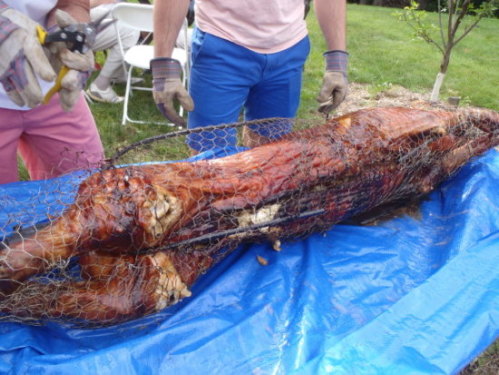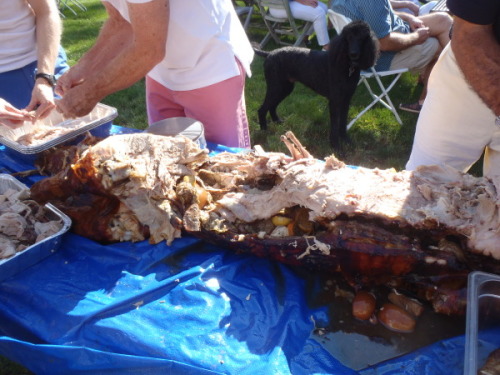
Helped roast a 130-lb. hog this weekend for a pal's garden party. It's quite the project. Night before, our cooking team seasoned the cavity with spices, filled it with apples and oranges, then stapled the cavity shut and pinned the ears back. Ran the spit through the mouth and out the back end, then the heavy prongs on the spit to hold the pig firm and acouple of long lug bolts with large square washers to pin the pig to the spit. Then chicken wire wrapped tightly around the whole thing to hold it all together.
After that, ten hours of tending the apple wood and charcoal fires in this corrugated steel contraption. Have to be careful because too much heat can set the pig on fire, and too little won't cook it. We figured keeping the temperature in there around 220-240 F. Slow cooking, and some smoking but not too much. After the first couple of hours, smoke can't penetrate anyway. You can not leave the thing unattended but it's good redneck fun with good company.
More pig roasting below the fold -
The spit is slowly turned, in this case, by an old coal scuttle electric engine.

Tending the fires

How do you know when it's done? You guess, by the look of it. If the hams aren't thoroughly cooked through, you can throw them in a microwave. In this case, the meat was falling off the bones just like you want it, and the skin was tasty potato chips.

When done, we lifted the pig on the spit onto a tarp, then onto a hitch-mounted cargo carrier and took it to the party. Everybody took pictures of the porcine treat. Unwrap the chicken wire, remove the spit, cut out the staples, pull the meat apart, a variety of freshly-made sauces, and voila - a feast for 120 guests with, I think, plenty of leftovers. With some kegs, cole slaw, cornbread, and cookies on a perfect early summer afternoon.


